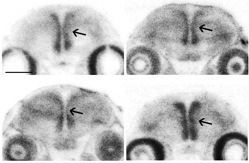We explicitly study a model in which nature and nuture must intersect for proper brain function and behavior. Genetic programming and experience have obvious interactions during sensitive periods - phases in life when a behavior is optimally acquired. We focus on the sensitive period for tutor song memorization; we work to identify neural mechanisms permissive for the onset of tutor song memorization, what occurs in the brain during tutoring experiences, and how age and experience are translated in the brain to close the sensitive period. Projects in the lab build on our previous work to further understand the genomic and anatomical changes that promote and limit the ability of young birds to learn song across development.
For example:
Experience-dependent regulation of synapses
A key component of both neural maturation and learning and memory mechanisms is the stabilization of synapses that support experience encoding and processing. We are particularly interested in genes that have constitutive roles in development and dynamic responses to experience in adults; this is a signature of ZENK (zif268, egr-1, ngfi-a, krox24), a transcription factor that led us to demonstrate that molecular regulation of transcription is required for song copying in the auditory forebrain. Current projects investigate how age- and experience- dependent regulation of neuritin, MEF2, and the mToR signaling cascade contribute to the ability of young male zebra finches to learn song via modulation of synapses.
Experience-dependent epigenomic modifications associated with learning potential
The sensitive period for tutor song memorization normally lasts from posthatch day 30-65 (P30-65). The close of this learning phase, when the birds have high learning potential, depends largely on experience with tutor song, not because of an age barrier. Chromatin immunoprecipitation followed by genome-wide DNA sequencing (ChIP-seq) for several histone modifications reveals that age-matched P65 brains have different histone modification profiles depending on whether or not the juvenile had experienced song. Epigenenetics may therefore be one key regulator of a bird's potential to learn from tutor experience.
Delivery of exogenous plasmid constructs for gene interference and expression
Songbirds have been long appreciated as a model because of the neural circuitry for song is visible with the naked eye, they are the most tractable lab model for the developmental and social requirements of human speech acquisition, and more recently, their sequenced genome. We have leveraged a strategy often employed in utero in rodents, electroporation, to fill a gap in the experimental toolbox for songbird neurobiology: the ability to genetically manipulate genes and cells. With this method, we expand our ability to perform in vivo alterations in the developing brain and assay circuit development, function, and behavioral outcomes.
Neural mechanisms for socially-mediated learning
Young males (female zebra finches do not sing) need to memorize a "tutor" bird's song to use as the foundation of their own song. Tutor song memorization is not random nor rote. The tutor tends to be the bird's dad, but we think that the early life social contacts a male has with individual potential tutor males biases who he copies. We are working to identify both the important experiental and molecular signaling components of this effect, with a focus on the h.



three mature zebra finch songs. Top: tutor song, Middle: accurate copy of tutor song, Bottom: poor copy of tutor song results from disruption of molecular signaling in the auditory cortex specifically during tutor experiences.
Neurosteroid regulation of neural plasticity & behavior

The song circuit is sensitive to steroids. Steroids are required for masculinization of the song control circuit, and alter the ability of a young male to learn or modify his song normally. The brain is the likely source of the steroids ("neurosteroids") that act on the song system. We aim to identify the genomic and molecular factors regulated by steroids that contribute to the potential for young males to accurately copy song.
four steroidogenic genes expressed in the major proliferative zone along the lateral ventricle in early developing brain